This is an old revision of this page, as edited by Al Khazar (talk | contribs) at 17:09, 7 February 2015 (Reverted 1 edit by 104.237.143.46 (talk) to last revision by Al Khazar. (TW)). The present address (URL) is a permanent link to this revision, which may differ significantly from the current revision.
Revision as of 17:09, 7 February 2015 by Al Khazar (talk | contribs) (Reverted 1 edit by 104.237.143.46 (talk) to last revision by Al Khazar. (TW))(diff) ← Previous revision | Latest revision (diff) | Newer revision → (diff) Main battle tank| T-90 | |
|---|---|
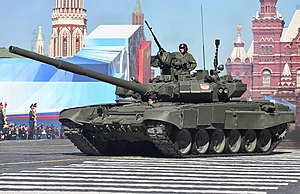 Russian Army T-90A tank on display during parade festivities in May 2013. Russian Army T-90A tank on display during parade festivities in May 2013. | |
| Type | Main battle tank |
| Place of origin | Russia |
| Service history | |
| In service | 1993–present |
| Used by | See Operators |
| Production history | |
| Designer | Kartsev-Venediktov |
| Manufacturer | Uralvagonzavod |
| Unit cost | $2.5 in 1999, $2.77 – 4.25 million USD in 2011 (varies by source) |
| Produced | 1992–present |
| No. built | 2,053+ |
| Specifications | |
| Mass | 47.5 tonnes (46.7 long tons; 52.4 short tons) |
| Length | 9.63 m (31 ft 7 in) |
| Width | 3.78 m (12 ft 5 in) |
| Height | 2.22 m (7 ft 3 in) |
| Crew | 3 |
| Armor | Steel-composite-reactive blend vs APFSDS: 550-650mm, with Kontakt-5 = 800–830mm; vs HEAT: 1,000mm with Kontakt-5 = 1,150–1,350mm |
| Main armament | 125 mm smoothbore gun with ATGM capability; mainly 9M119 Svir |
| Secondary armament | 12.7mm Kord Heavy machine gun, 7.62mm PKMT |
| Engine | Model 84 V-84 12-cyl. diesel V-92 12-cyl. diesel |
| Power/weight | 18.1 hp/tonne (13.5 kW/tonne) for V-84 12-cyl. diesel engine 20.4 hp/tonne (15.8 kW/tonne) for V-92 12-cyl. diesel engine |
| Suspension | Torsion bar |
| Operational range | 550–700 km (340–430 mi) (depending on type of engine) |
| Maximum speed | 60–65 km/h (37–40 mph) (depending on type of engine) |
| T-64 tanks | |||||||
|---|---|---|---|---|---|---|---|
| T-64 |
| ||||||
| T-72 |
| ||||||
| T-80 |
| ||||||
| T-90 |
| ||||||
| Tanks of the post–Cold War era | |
|---|---|
| Main battle |
|
| Light / medium | |
| Prototypes, experimentals | |
Background: History of the tank, Tank classification | |
The T-90 is a Russian third-generation main battle tank that is essentially a modernisation of the T-72B, incorporating many features of the T-80U (it was originally to be called the T-72BU, later renamed to T-90). It is currently the most modern tank in service with the Russian Ground Forces and Naval Infantry. Although a development of the T-72, the T-90 uses a 125mm 2A46 smoothbore tank gun, 1G46 gunner sights, a new engine, and thermal sights. Standard protective measures include a blend of steel, composite armour, smoke mortars, Kontakt-5 explosive-reactive armour, laser warning receivers, Nakidka camouflage and the Shtora infrared ATGM jamming system. The EMT-7 electromagnetic pulse (EMP) creator has been used in testing but not fitted to T-90s in active service. It is designed and built by Uralvagonzavod, in Nizhny Tagil, Russia. Since 2011, the Russian armed forces have ceased ordering the T-90, and are instead waiting for the development of the Armata Universal Combat Platform that is expected to enter service in 2016.
Development
By 1992, the Russian Ministry of Defence announced that it could no longer afford to manufacture two main battle tanks in parallel. Since both the "quality" T-80U and the cheaper "quantity" T-72B were being built at different plants, and each plant was critical to the economy of its city, the government gave small orders to both. Omsk built five T-80Us and Nizhny Tagil built fifteen T-72s, and both built more in the hopes of winning large export orders. Nizhny Tagil had built a few T-72BAs, T-72Bs upgraded with a third generation add-on explosive reactive armour (ERA) called Kontakt-5, which was already in service on the T-80U.
To further improve the T-72's export prospects and its chances of being selected as Russia's sole production main battle tank, the T-80U's more sophisticated fire control system was also added to produce a vehicle designated T-72BU. The T-90 was developed by the Kartsev-Venediktov Design Bureau at the Uralvagonzavod factory in Nizhny Tagil. The production model is based on the T-72BM, with some added features from the T-80 series.
The T-90 with an 830 hp (620 kW) engine went into low-level production in 1993, based on a prototype designated T-88. It features a new generation of Kontakt-5 explosive reactive armour on its hull and turret. Of conventional layout, the T-90 represents a major upgrade to every system in the T-72, including the main gun. The T-90S have been identified as export model. The references to a T-90E appear to be unsubstantiated. The T-90 is fitted with a "three-tiered" protection system: the first tier is the composite armour in the turret, second tier is third generation Kontakt-5 ERA and third tier is a Shtora-1 countermeasures suite.
T-90s were used in combat for the first time during the invasion of Dagestan in 1999.
Production and service history
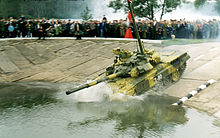
The Russian Defence Ministry made a selection of a single main battle tank (MBT) in 1995. The T-80 was more expensive and its delicate, fuel-hungry gas turbine engine provided a questionable advantage. In addition, the older T-80BV tanks performed poorly in urban combat in the First Chechen War.
By September 1995, some 107 T-90 tanks had been produced, located in the Siberian Military District. By mid-1996 some 107 T-90s had gone into service in the Far Eastern Military District.
1999 saw the appearance of a new model of T-90, featuring the fully welded turret of the Object 187 experimental MBT instead of the original T-90's cast turret. This new model is called "Vladimir" in honour of T-90 Chief Designer Vladimir Potkin, who died in 1999. It is unknown how this design affects the protection and layout of the turret, or whether the tank's hull armour layout was changed.

The T-90A saw combat action during the 1999 Chechen invasion of Dagestan. According to Moscow Defence Brief, one T-90 was hit by seven RPG anti-tank rockets but remained in action. The journal concludes that with regular equipment T-90A seems to be the best protected Russian tank, especially if the Shtora and Arena defensive protection systems are integrated in it.
In 2007, there were about 334 T-90 tanks serving in the Russian Ground Forces' 5th Guards Tank Division, stationed in the Siberian Military District, and seven T-90 tanks in the Navy. Some 31 new T-90 tanks were expected to enter service in 2007, and 60 in 2008.
The Russian Federal Service for Defence Contracts (Rosoboronzakaz) announced in July 2008 that a new tank (which rumour has previously referred to as the T-95) was due to be introduced in 2009, but development was cancelled in May 2010.
Russia is developing a new Universal Combat Platform T-99 (also known as Armata) to be ready for use by 2015. It is expected to have a more powerful engine, improved armour, main gun and autoloader, with ammunition storage separated from the crew.
Export
India
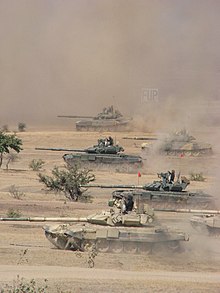
In 2001, India bought 310 T-90S tanks from Russia, of which 120 were delivered complete, 90 in semi-knocked down kits, and 100 in completely knocked down kits. The T-90 was selected because it is a direct development of the T-72 that India already employs with 60% logistics commonality with T-90 simplifying training and maintenance. India bought the T-90 after the delay in production of the domestically developed Arjun main battle tank, and to counter Pakistani deployment of the Ukrainian T-80UD in 1995–97. These tanks were made by Uralvagonzavod and the updated 1,000 hp (750 kW) engines were delivered by Chelyabinsk Tractor Plant. These tanks however did not feature the Shtora-1 passive/active protection system though there are reports that a separate contract for shipment of a modernised version of this suite is being discussed.
A follow-on contract, worth $800 million, was signed on October 26, 2006, for another 330 T-90M "Bhishma" MBTs that were to be manufactured in India by Heavy Vehicles Factory at Avadi, Tamil Nadu.
The T-90M Bhishma is a customised, improved version of the T-90S, which India developed with assistance from Russia and France, with both of whom India has very close ties. (Bhishma was a near invincible warrior in the ancient Hindu epic, the Mahabharata). The tanks are equipped with the French Thales built Catherine-FC thermal sights and utilises Russian Kontakt-5 K-5 explosive reactive armoured plates. Kontakt-5 (K-5) ERA in its export variant provides a protection level of 1.2 against Kinetic Energy (APFSDS) rounds and 1.7–1.8 against Chemical Energy rounds (Tandem HEAT). Semi-active baffle plates and ceramic layers with high tensile proprieties are employed in T-90 base armour. Even more advanced armour composition was implemented in the welded turrets of domestic T-90s and on export T-90 Bhishma tanks for India. In several tests conducted in front of an Indian delegation the latest foreign M829A2/KEW-A2 APFSDS ammunitions were fired from 250 metres against a T-90S lacking the normal built-in explosive reactive armour (ERA) Kontakt-5 (K-5) The turret proved completely impenetrable, which proved to be crucial in selling the T-90 Bhishma MBT to India.
In April 2008, the Indian Army sent a request for proposal to Rafael, BAE Systems, Raytheon, Rosoboronexport, Saab, and IBD Deisenroth Engineering for an active protection system for the T-90S Bhishma. The contract is expected to be worth US$270 million. Saab's LEDS-150 won the contract in January 2009.
A third contract, worth $1.23 billion, was signed in December 2007 for 347 upgraded T-90Ms, the bulk of which will be licence-assembled by HVF. The Army hopes to field a force of over 21 regiments of T-90 tanks and 40 regiments of modified T-72s. The Indian Army would begin receiving its first T-90M main battle tank in completely knocked-down condition from Russia’s Nizhny Tagil-based Uralvagonzavod JSC by the end of 2009.
The T-90M features the 'Kaktus K-6' bolted explosive reactive armour (ERA) package on its frontal hull and turret-top (the T-90S has 'Kontakt-5' ERA), is fitted with an enhanced environmental control system supplied by Israel's Kinetics Ltd for providing cooled air to the fighting compartment, has additional internal volume for housing the cryogenic cooling systems for new-generation thermal imagers like the THALES-built Catherine-FC thermal imager (operating in the 8–12 micrometre bandwidth). In all, India plans to have 1,640 T-90 tanks in service by 2018–2020.
The first batch of 10 licence built T-90M "Bhishma" was inducted into the Indian army on August 24, 2009. These vehicles were built at the Heavy Vehicles Factory at Avadi, Tamil Nadu.
A ₹10,000 crore (US$1.2 billion) purchase of 354 new T-90MS tanks for six tank regiments for the China border has been approved which would take the total number of T-90 tanks in the Indian Army's inventory to 2011 and with a total of nearly 4500 tanks (T-90 and variants, T-72 and Arjun MBT) in active service, the world's third largest operator of tanks.
India plans to have 21 tank regiments of T-90s by 2020, with 45 combat tanks and 17 training and replacement tanks per regiment, for 62 total each.
On 17 September 2013, India's Defence Ministry approved the production of 235 T-90 tanks under Russian licence for $1 billion.
Other
The Cyprus House Defence Committee approved funds in January 2009 for the purchase of 41 Russian-built T-90 tanks. The money is included as part of the 2009 defence budget. Cyprus already operates the Russian-made T-80 tank. In March 2010 it was reported that Cyprus had opted for 41 additional T-80s instead of purchasing T-90s.
Anonymous Venezuelan defence sources said that president Hugo Chavez "wants to replace his army's obsolete AMX-30 main battle tanks with between 50 and 100 Russian-built T-90 main battle tanks," according to an October 2008 article by analyst Jack Sweeney. In September, 2009 a deal was announced for 92 T-72s only. Saudi Arabia was reported, in July 2008, by Russian daily Kommersant to be in negotiations to buy 150 T-90 tanks. Lebanese Defence Minister Elias El Murr met with Russian Defence Minister Anatoly Serdyukov in December 2008, when they discussed the possibility of a transfer of military equipment including T-90 tanks.
In February 2010, an arms deal was signed between Libya and Russia. Details of the sale were not immediately released, but a Russian diplomat stated that Libya had wanted 20 fighter planes, air defence systems, and may also be interested in purchasing "several dozen" T-90s, and modernising a further 140 T-72s. However after Libya's crackdown on anti-government protesters in early 2011, the United Nations enacted an international arms embargo on Libya resulting in the cancellation of Russian arms deals.
In April 2013, Rosoboronexport requested for the entry of the T-90S in an upcoming tender by the Peruvian Army for main battle tanks. Peru sought to acquire between 120 and 170 tanks to replace its aging T-55 tanks. The T-90 was tested against the M1A1 Abrams from the United States, the Leopard 2A4 offered from the Spanish Army, Leopard 2A6s formerly operated by the Dutch Army, and T-64s and T-84s offered by Ukraine. By September 2013, only the T-90S, the Russian T-80, the Ukrainian T-84, and American M1A1 were still competing. On 19 September 2013, a T-90S was demonstrated to the Commander-in-Chief of the Peruvian Land Forces and 300 officers. During the day, the tank's combat and running capabilities were shown. At night, the accuracy of all weapons at different ranges while stationary and on the move were shown under limited visibility and mountainous terrain conditions. A Peruvian T-55 driver was briefed for 5 minutes about the controls, then was able to move and operate the T-90S, demonstrating the commonality of the two vehicles. Russia pushed for the sale of 110 T-90S tanks.
The People's Army of Vietnam is reportedly interested in buying the T-90 to keep its military capability in step with its neighbours.
Design
Armament
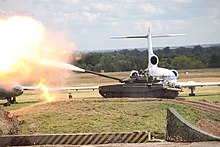

The T-90's main armament is the 2A46M 125 mm smoothbore tank gun. This is a highly modified version of the Sprut anti-tank gun, and is the same gun used as the main armament on the T-80-series tanks. It can be replaced without dismantling the inner turret and is capable of firing armour-piercing fin-stabilised discarding sabot (APFSDS), high-explosive anti-tank (HEAT-FS), and high explosive fragmentation (HE-FRAG) ammunition, as well as 9M119M Refleks anti-tank guided missiles. The Refleks missile has semi-automatic laser beam-riding guidance and a tandem hollow-charge HEAT warhead. It has an effective range of 100 m to 6 km, and takes 17.5 seconds to reach maximum range. Refleks can penetrate about 950 millimetres (37 in) of steel armour and can also engage low-flying air targets such as helicopters.
The NSV 12.7mm (12.7x108) remotely controlled anti-aircraft Heavy machine gun can be operated from within the tank by the commander and has a range of 2 km and a cyclic rate of fire of 700–800 rounds per minute with 300 rounds available (the NSV was replaced by the Kord heavy machine gun in the late 1990s). The PKMT 7.62mm (7.62x54mm R) coaxial machine gun weighs about 10.5 kg while the ammunition box carries 250 rounds (7,000 rounds carried) and weighs an additional 9.5 kg.
Like other modern Russian tanks the 2A46M in the T-90 is fed by an automatic loader which removes the need for a manual loader in the tank and reduces the crew to 3 (commander, gunner, and driver). The autoloader can carry 22 ready-to-fire rounds in its carousel and can load a round in 5–8 seconds. It has been suggested that the automatic loaders on modern T-90 tanks have been modified to take advantage of newer ammunition such as the 3BM-44M APFSDS, which like the US M829A3 penetrates armour better than the previous shorter rounds. HEAT rounds that can be fired from the 2A46M includes the 3BK21B (with a Depleted uranium liner), 3BK29 (with a credited penetration of 800 mm RHA equivalency), and the 3BK29M (with a Triple-tandem charge warhead). Additionally the T-90 features the Ainet fuse setting system which allows the tank to detonate 3OF26 HE-FRAG rounds at a specific distance from the tank as determined by the gunners laser rangefinder, improving its performance against helicopters and infantry. Accurate firing range HE-Frag-FS 10 km, APFSDS 4 km
Fire-control system T-90 showed the following features combat shooting during state testing. Heavily armoured targets at ranges of up to 5 km tank T -90 strikes on the move (up to 30 km/h) with a high probability hit the first shot. During state testing was made 24 launch missiles at ranges of 4–5 km and they all hit the target (all missile launches were made by inexperienced professionals), an experienced gunner for 54 traffic at speeds of 25 km/h, 7 real shells hit armoured targets located at ranges of 1,500–2,500.
Fire-control system on the T-90 includes the PNK-4S/SR AGAT day and night sighting system mounted at the commanders station which allows for night time detection of a tank sized target at ranges between 700 and 1100 metres depending on the version of the sight. Early models of the T-90 were equipped with the TO1-KO1 BURAN sight but later models (T-90S) were upgraded to use the ESSA thermal imaging sight, which allows for accurate firing to a range of 5,000–8,000 m using the CATHERINE-FC thermal camera produced by Thales Optronique. The gunner is also provided with the 1G46 day sighting system which includes a laser range finder, missile guidance channel and allows tank-sized targets to be detected and engaged at 5 to 8 kilometres (3.1 to 5.0 mi). The driver users a TVN-5 day and night sight. In 2010, Russia started licensed production of Thales-developed Catherine FC thermal imaging cameras for T-90M tanks, a Russian daily said. These thermal imagers are also present on T-90M "Bhishma" built in India under licence.
Mobility
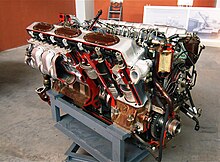
The main propulsor is the B-92C (V-92S) diesel engine, built in the ChTZ. Different models of the T-90 tank are powered by various motors in its initial models, like the V-84MS 618 kW (840 hp) four-stroke V-12 piston engine, uprated 1,000 hp (750 kW) engines and 1,250 hp (930 kW) engines made by Uralvagonzavod and are delivered by Chelyabinsk Tractor Plant. The Т-90S with 1,000 hp (750 kW) engine can attain a top speed of 60 km/h on the road and up to 45 km/h on rough terrain. T-90 tank has classic arrangement of transmission, with rear placed engine and transmission. The 1,000 hp (750 kW) engines are V-92 four stroke, 12 cylinder, multi-fuel diesel while 1,250 hp (930 kW) engine is V-96. The T-90 export version i.e. modified T-90S is fitted with increased power multi-fuel 1,000-h.p. diesel engine with turbochargers. The tank is also fitted with an air conditioning system for work in high temperature zones.
Protection

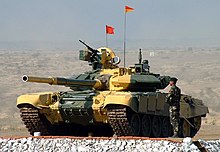
The T-90 is fitted with a "three-tiered" protection system. The first tier is the composite armour in the turret, consisting of basic armour shell with an insert of alternating layers of aluminum and plastics and a controlled deformation section.
The second tier is third generation Kontakt-5 ERA (explosive reactive armour) which significantly degrades the penetrating power of kinetic-energy APFSDS ammunition and also these ERA blocks give the turret its distinctive angled "clam shell" appearance. ERA bricks are also located on the turret roof and provide protection from top-attack weapons. The turret's forward armour package, in addition to the ERA and steel plating, contains a composite filler of Russian composite armour sandwiched between upper and lower steel plates. The composite armour results in a lower weight and improved protection when compared with steel-only armour.
The third tier is a Shtora-1 (Russian: Штора-1 or "curtain" in English) countermeasures suite, produced by Elektromashina of Russia. This system includes two electro-optical/IR "dazzlers" on the front of the turret (which gives the distinct Red Eyes), four Laser warning receivers, two 3D6 aerosol grenade discharging systems and a computerised control system. The Shtora-1 warns the tank's crew when the tank has been 'painted' by a weapon-guidance laser and allows the crew to slew the turret to face the threat. The infrared jammer, the TShU1-7 EOCMDAS, jams the semiautomatic command to line of sight (SACLOS) guidance system of some anti-tank guided missiles. The aerosol grenades are automatically launched after Shtora detects that it has been painted. The aerosol grenades are used to mask the tank from laser rangefinders and designators as well as the optics of other weapons systems. Indian T-90S tanks are not equipped with the Shtora-1 countermeasures suite. They will be equipped with the LEDS-150 Land Electronic Defence System.
In addition to the passive and active protection systems the T-90 is also fitted with nuclear, biological and chemical (NBC) protection equipment, KMT mine sweeps and an automatic fire fighting system. The EMT-7 electromagnetic-counter mine system can also be installed on the T-90. EMT-7 emits an electromagnetic pulse to disable magnetic mines and disrupt electronics before the tank reaches them. The Nakidka signature reduction suite is also available for the T-90. Nakidka is designed to reduce the probabilities of an object to be detected by Infrared, Thermal, Radar-Thermal, and Radar bands.
During a reported test conducted by the Russian military in 1999 the T-90 was exposed to a variety of RPG, ATGM and APFSDS munitions. When equipped with Kontakt-5 ERA the T-90 could not be penetrated by any of the APFSDS or ATGM used during the trial and outperformed a T-80U which also took part. During combat operations in Dagestan, there were witness accounts of one T-90 sustaining seven hits from RPGs, and remaining in action.
T-90MS has ERA Relict. Relict defends against tandem warheads and reduces penetration of APFSDS rounds by over 50 percent. Relict can be installed instead of Kontakt-1/Kontakt-5.
Variants



- T-90 – The first production version.
- T-90K – Commander's version of the T-90, with additional communication (station R-163-50K) and navigation equipment (TNA-4-3).
- T-90E – Export version of T-90 MBT.
- T-90A – Russian army version with welded turret, V-92S2 engine and ESSA thermal viewer. Sometimes called T-90 Vladimir.
- T-90AK – Command version of T-90A.
- T-90S – Export version of the T-90A. These tanks were made by Uralvagonzavod and were updated with 1,000 hp (750 kW) engines made by Chelyabinsk Tractor Plant. These tanks however do not feature the Shtora-1 passive/active protection system. Sometimes called T-90C (Cyrillic letter es looks like a Latin c). These tanks are found with two different turret armour arrays.
- T-90SK – Commander's version of the T-90S, with additional communication and navigation equipment.It differs in radio and navigation equipment and Ainet remote-detonation system for HEF rounds.
- T-90S "Bhishma" – modified T-90S in Indian service.
- T-90AM – Latest version of the T-90A. The main features include the modernisation of the old turret design, which is equipped with a new advanced fire control system "Kalina" (with integrated combat information and control systems), a new automatic loader and a new upgraded gun 2A46M-5, as well as a remote-controlled anti-aircraft gun "UDP T05BV-1". The new version also includes the Relikt (Реликт (динамическая защита)) ERA bricks instead of the Kontakt-5 ERA bricks. Other improvements include a new 1130HP engine, an enhanced environmental control system, and satellite navigation systems.
- T-90SM – New modernised (M) version of the export tank T-90S, with a 1130HP engine, a PNM Sosna-U gunner view, a 7.62 mm turret UDP T05BV-1 RWS, GLONASS, inertial navigation systems and new explosive reactive armour (ERA). A new removable turret bustle is included, which provides storage for eight additional rounds.
- Derivatives
- BREM-72: Armoured recovery vehicle.
- MTU-90: Bridge layer tank with MLC50 bridge.
- IMR-3: Combat engineer vehicle.
- BMR-3: Mine clearing vehicle.
Operators
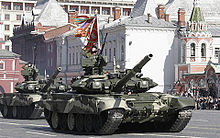
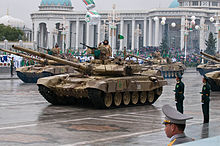
 Algeria: Algeria has purchased a total of 305 T-90SA tanks in two batches. The first batch of 185 was signed during 2009 and the second batch of 120 was signed in 2011 for $470 million.
Algeria: Algeria has purchased a total of 305 T-90SA tanks in two batches. The first batch of 185 was signed during 2009 and the second batch of 120 was signed in 2011 for $470 million. Azerbaijan: 100 T-90S (option for 100 more)
Azerbaijan: 100 T-90S (option for 100 more) India: India currently operates up to 620 T-90 which were procured in three separate orders. Two batches (310 tanks and knockdown kits in 2000 and a further 300 in 2006) were purchased from Russia. Heavy Vehicle Factory (HVF) at Avadi has delivered 24 tanks in 2009-10; 51 in 2010-11; another 50 were supposed to be delivered in 2012. A further 1,000 were to be produced locally by 2020. Of those, the first batch of 10 were delivered in August 2009. A ₹10,000 crore (US$1.2 billion) purchase of 354 new T-90MS tanks for six tank regiments for the China border has been approved. This takes total of T-90 tanks to 2011.
India: India currently operates up to 620 T-90 which were procured in three separate orders. Two batches (310 tanks and knockdown kits in 2000 and a further 300 in 2006) were purchased from Russia. Heavy Vehicle Factory (HVF) at Avadi has delivered 24 tanks in 2009-10; 51 in 2010-11; another 50 were supposed to be delivered in 2012. A further 1,000 were to be produced locally by 2020. Of those, the first batch of 10 were delivered in August 2009. A ₹10,000 crore (US$1.2 billion) purchase of 354 new T-90MS tanks for six tank regiments for the China border has been approved. This takes total of T-90 tanks to 2011. Russia: Russia operates 930 T-90A as of 2014.
Russia: Russia operates 930 T-90A as of 2014. Turkmenistan: Turkmenistan ordered 10 T-90S tanks in 2010 for approximately $30 million. A followup order for an additional 30 tanks was later placed.
Turkmenistan: Turkmenistan ordered 10 T-90S tanks in 2010 for approximately $30 million. A followup order for an additional 30 tanks was later placed. Uganda: Uganda may have ordered up to 100 T-90S tanks in 2010 for $340 million. At least 44 have been delivered.
Uganda: Uganda may have ordered up to 100 T-90S tanks in 2010 for $340 million. At least 44 have been delivered.
See also
Tanks of comparable role, performance and era
- BM Oplot: Ukrainian main battle tank
- PT-91: Polish main battle tank
- AMX Leclerc: French main battle tank
- Ariete: Italian main battle tank
- Type 90 Kyū-maru: JGSDF main battle tank (Japan)
- K2 Black Panther: South Korean main battle tank
- Al-Khalid: Pakistan main battle tank
- Type 99: Chinese main battle tank
- Leopard 2: German main battle tank
- M1 Abrams: US main battle tank
- Challenger 2: British main battle tank
- Zulfiqar (tank): Iranian Main Battle tank
- Arjun MBT: Indian main battle tank
- Pokpung-ho: North Korean main battle tank
- Merkava: Israeli main battle tank
- Altay: Turkey main battle tank
Notes
- "-300 -1". Retrieved 15 November 2014.
- "Denial of Defense Procurement MBT T-90 is not connected with the qualitative characteristics of this sample of military equipment – Ministry of Industry of the Russian Federation". Arms-Tass. March 17, 2011. Retrieved March 19, 2011.
- "T-90". btvt.narod.ru. Retrieved April 11, 2014.
- "Модернизированный танк Т-90С "Тагил" во всей красе". Retrieved 15 November 2014.
- John Pike. "T-90". Retrieved 15 November 2014.
- Zaloga, Steven (1993). T-72 Main Battle Tank 1974–93. Reading: Osprey Publishing. p. 45. ISBN 978-1-85532-338-4.
- Lenta.ru: Наука и техника: Бронетехника раздора
- ^ "T-90". globalsecurity.org.
- Zaloga 2000, p 3.
- Warford, James M (September–October 1997). The Russian T-90S: Coming into Focus (PDF). US Army.
{{cite book}}:|work=ignored (help), quoting Russian newspaper sources - T-90. Federation of American Scientists.
{{cite book}}:|work=ignored (help) - Pashin, Alexander. "Russian Army Operations and Weaponry During Second Military Campaign in Chechnya". Moscow Defense Brief (3/2002). Centre for Analysis of Strategies and Technologies. Retrieved May 29, 2009.
- ^ "T-90/S MBT".
- "Ares Homepage". Aviation Week. Retrieved July 8, 2010.
- "Russian army to start receiving new-generation tanks in 2014". En.rian.ru. September 11, 2001. Retrieved September 11, 2011.
- "T-90 Main Battle Tank". Vasiliy Fofanov's Modern Russian Armor Page.
- Dunnigan, James. "Get the T-90s Out of the Kitchen", StrategyPage, June 24, 2006.
- "T-90S "Bhishma"" (PDF). ipcs.org. February 1, 2004.
- "The situation in the domestic tank building, truth and fiction Tarasenko, S. Tupitsyn". Arms and equipment yesterday, today and tomorrow, 2006 page 10-15. November 1, 2006.
- India changes its top defence supplier
- Prasun K Sengupta (January 28, 2009). "TRISHUL: India's 'Born Again' T-90M MBT". Trishulgroup.blogspot.com. Retrieved September 11, 2011.
- ^ John Pike. "T-90 Bhisma". Globalsecurity.org. Retrieved February 7, 2010.
- RIA Novosti Dmitry Korobeinikov (August 24, 2009). "Indian army receives first T-90 tanks made under Russian license". RIA Novosti. Retrieved February 7, 2010.
- "Armor: The Frugal T-90". Strategypage.com. October 4, 2008. Retrieved February 7, 2010.
- ^ "Army scuttles Arjun trials to push through Russian T-90 purchase". Business Standard. 2012-11-26. Retrieved 2012-11-29.
- Indian T-90s Get 5,000 Meter Reach - Strategypage.com, 4 September 2013
- India has approved the manufacture of 235 T-90 main battle tanks under Russian license - Armyrecognition.com, 19 September 2013
- "Greek-Cypriots to Buy Russian Tanks, Considering Missile Purchases", defenseworld.net, January 12, 2009.
- Новую оружейную сделку с Россией обнародовал Кипр. Kommersant (in Russian). March 13, 2010. Retrieved March 17, 2010.
- Jack Sweeney "Venezuela buys Russian aircraft, tanks to boost power". UPI.com, October 15, 2008.
- "Venezuela Will Load Urals Defence Plants With Work". Rus Business News. September 16, 2009. Retrieved October 10, 2009.
- Faulconbridge, Guy (July 15, 2008). "Saudi offers Russia arms deal to curb Iran ties". Reuters. Archived from the original on July 12, 2008.
{{cite journal}}:|archive-date=/|archive-url=timestamp mismatch; December 7, 2008 suggested (help); Cite journal requires|journal=(help) - "Lebanese press round-up: December 17, 2008". An-nahar Newspaper. NOW Lebanon. December 17, 2008. Retrieved January 8, 2009.
- Ronen, Gil (December 17, 2008). "Russia to Sell Lebanon Advanced Jets 'at Discount'". Israel National News. Retrieved January 8, 2009.
- "Libya strikes billion-dollar Russian arms deal". AFP. January 30, 2010.
- "Libya, Russia agree $1.8-billion arms deal: Putin". Reuters. January 30, 2010.
- Peru; Main Battle Tanks- new contestants emerge - Dmilt.com, April 30, 2013
- Peru; Future main battle tank projects lags on despite criticism - Dmilt.com, 2 September 2013
- T-90S Russian-made main battle tank in field demonstration for the Peruvian Army - Armyrecognition.com, 27 September 2013
- Russia to promote Pantsir-S1 air defence system to Brazil and T-90S main battle tank to Peru - Armyrecognition.com, 9 October 2013
- Vietnam would like to buy Russian-made T-90 main battle tanks to increase its military power - Armyrecognition.com, 10 January 2014
- "125mm APERS And Special Rounds". Fofanov.armor.kiev.ua. Retrieved July 8, 2010.
- "Сравнение танков - Altay, Leopard 2a, Т-90". Retrieved 15 November 2014.
- "-90 -". Retrieved 15 November 2014.
- http://www.sinopa.ee/sor/boraznoe/t90/t9002.htm
- "Russia to start licensed production of foreign military equipment". RIA Novosti. May 21, 2010. Retrieved July 8, 2010.
- "EMT-7 electromagnetic countermine system (Russian Federation)". Jane's. June 20, 2011. Retrieved September 11, 2011.
- http://www.modernarmy.ru/article/335/osnovnoy-tank-t-90
- "20.10.1999 T-80U and T-90 Protection Trials (Vasily Fofanov)". Archived from the original on January 29, 2008.
- Alexander Pashin. "Russian Army Operations and Weaponry During Second Military Campaign in Chechnya". Centre for Analysis of Strategies and Technologies. Archived from the original on January 29, 2009.
- "T-90MS main battle tank data sheet specifications information specifications pictures-Army Recognition-Army Recognition". Retrieved 15 November 2014.
- "Танк Т-90МС: анализ основных характеристик и возможные пути дальнейшего повышения боевых качеств". Военно-патриотический сайт «Отвага». Retrieved 15 November 2014.
- T-90MS Tagil - Military-Today.com
- Oleg Kropotkin. "Комплекс ДЗ типа "Реликт" для танков". Retrieved 15 November 2014.
- ^ "T-90 Rosja" (in Polish). pancerni.net.
- ^ "T-90" (in Polish). militarium.net.
- ^ "Main Battle Tank – T-90/T90S/T90C". armorsite.
- "ОСНОВНОЙ ТАНК Т-90АМ (Т-90МС). MAIN BATTLE TANK T-90АМ (T-90MS)". Retrieved 15 November 2014.
- http://tank-t-90.ru/index/t90am/0-78
- "T-90MS main battle tank". Retrieved 15 November 2014.
- "Rosoboronexport T-90MS at IDEX 2013". Retrieved 15 November 2014.
- New Russian tank – T-90MS, 2012-12-01.
- ^ "Algeria, Turkmenistan To Buy Russian Tanks: Report". February 14, 2012. Retrieved March 3, 2012.
- "ТАСС: Политика - Россия поставила Азербайджану 100 танков Т-90С". ТАСС. Retrieved 15 November 2014.
- "Indian Army inducts first indigenous T-90 tanks". ThaiindianNews.
- "Army to acquire nearly 1000 additional T-90 tanks by 2020". October 4, 2006. Retrieved October 3, 2009.
- "T-90/S MBT". Warfare.ru. September 5, 2010. Retrieved September 11, 2011.
- Модернизация танка Т-90 будет завершена до конца 2010 года » Военное обозрение
- "Trade Registers". Armstrade.sipri.org. Retrieved 2014-11-20.
References
- Mallika, Joseph (2004) "Issue Brief No. 19: T-90S 'Bhishma'". Institute of Peace and Conflict Studies. URL accessed July 24, 2006.
- Sewell, Stephen "Cookie" (July–August 1998). "Why Three Tanks?". (PDF format)
- Zaloga, Steven and David Markov (2000), Russia's T-80U Main Battle Tank, Hong Kong: Concord, ISBN 962-361-656-2.
External links
- T-90 MBT Military Today
- T-90S main battle tank
- T-90MS main battle tank(Army Recognition)
- T-90S Third-Generation Main battle tank, uralvagonzavod
- T-90MS Tagil(Military Today)
- T-90S Main Battle Tank—Bharat Rakshak
- Uralvagonzavod, manufacturer's English-language home page (Russian, T-90 English page)
- The T-90 tank by the Federation of American Scientists
- T-90S Main Battle Tank at the Armor Site
- Main battle tank T-90: Firing sample
- Main battle tank T-90 at GlobalSecurity.org
- T-90 Main Battle Tank
| Soviet and Russian armoured fighting vehicles after World War II | |||||||||
|---|---|---|---|---|---|---|---|---|---|
| |||||||||
| |||||||||
| |||||||||
| |||||||||
| |||||||||